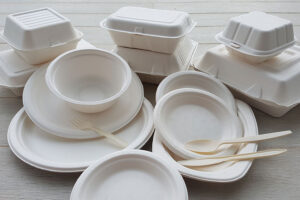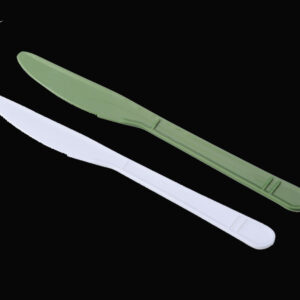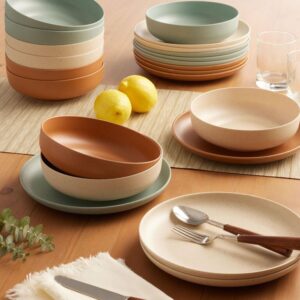Biodegradable tableware, as the name suggests, is fully compostable and biodegradable; as such, they are widely used worldwide to reduce plastic waste and greenhouse gas emissions, such as methane emissions. Such tableware can be made from disposable materials such as bagasse, bamboo, and paper pulp. This tableware is strong and environmentally friendly. Biodegradable tableware includes food containers and utensils such as bowls, plates, cups, and dinner plates, which decompose within 30 to 60 days of disposal.

Biodegradable cornstarch tableware
Biodegradable cornstarch tableware products are made using all tree-free materials, specifically cornstarch, which consists of 90% corn starch. 100% natural and healthy.
A certain amount of water is added to the corn starch and blended in a mixer. Then a certain amount of material is loaded into a press and prototyped through a press. Then a waterproof film is applied to the inner surface of the product, dried, and packaged.
It is a polymer, and the composition includes PVTC, acrylic, bioplastic, and water.
The market prospect of biodegradable cornstarch tableware
Biodegradable tableware is eco-friendly from waste materials such as bagasse, rice husk, and coconut shells. Rising awareness about environmental pollution is driving the global biodegradable tableware market. It has been observed that there is a growing number of emerging green businesses across the globe. Hence, there is a growing potential for the production and use of biodegradable tableware. Increasing awareness about the adverse effects of plastics on aquatic and aerial organisms, among others, is contributing to the growth of the market. Biodegradable tableware combines the convenience of disposable plates with the benefit of having little to no negative environmental impact. Increasing economic awareness regarding the use of plastic and other toxic materials for tableware and increasing investments in research and development of compostable materials are encouraging market growth. The global biodegradable tableware market was valued at USD 2,754.9 million in 2018 and is expected to reach USD 4,355.1 million by 2026, growing at a CAGR of 6.01% from 2019 to 2026.
Biodegradable tableware is an eco-friendly alternative to plastic tableware products. Manufacturers are relying on biodegradable waste to produce biodegradable tableware. Bagasse – a residue left over from the extraction of sap from straw – rice bran, wheat, and corn are used to develop biodegradable tableware. For example, Hengfeng makes biodegradable tableware derived from wheat bran. In addition, manufacturers are exploring recyclable waste, such as fallen palm leaves and waste paper, broadening the horizons of their product lines.
The most popular eco-friendly tableware is made from corn, betel nut leaves, bagasse, and rice hulls. The remains of fast-growing trees have been utilized for many years. In areas where bamboo is abundant, such as India, the demand for biodegradable tableware made from bamboo has gathered momentum.







